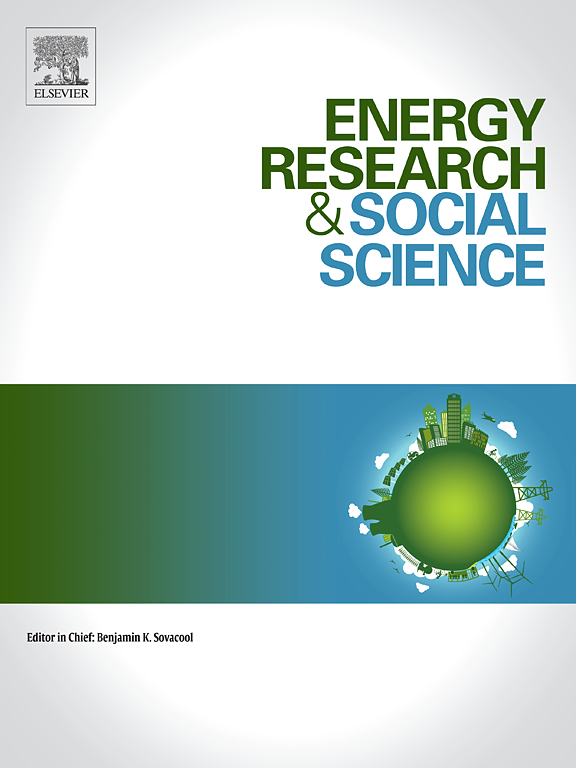太阳能城市:扩大太阳能获取的城市层面推动者的案例研究分析
IF 7.4
2区 经济学
Q1 ENVIRONMENTAL STUDIES
引用次数: 0
摘要
屋顶太阳能光伏(PV)的采用可以通过减少电费和提高能源弹性而使家庭受益。在美国,低收入和中等收入(LMI)家庭比高收入家庭更不可能采用光伏发电并体验到这些好处。采用者收入趋势通常是通过定量分析来探索的,但解释力有限。我们的定量分析只能通过社会经济因素(如房屋中值和收入不平等)和光伏市场因素(如累积采用和激励)来解释LMI采用趋势在城市层面上的三分之一左右的变化。为了更好地了解影响光伏采用者收入趋势的因素,我们对三个LMI光伏采用率相对较高的城市进行了半结构化访谈。案例研究在一定程度上重申了定量分析的结果,例如光伏激励的作用。案例研究揭示了定量分析中遗漏的更广泛的LMI采用驱动因素。案例研究显示了城市环境如何影响LMI的采用,例如支持性城市政府的作用。案例研究还揭示了伙伴关系的重要性,例如市政府与州LMI光伏项目实施者之间的伙伴关系。最后,受访者强调了在潜在的LMI PV采用者之间建立信任的重要性。受访者表示,合作伙伴关系、外联和消费者保护措施对于在LMI家庭中建立对光伏安装商的信任至关重要。本文章由计算机程序翻译,如有差异,请以英文原文为准。
Solar cities: A case study analysis of city-level enablers of expanded solar energy access
Rooftop solar photovoltaic (PV) adoption can benefit households by reducing electricity bills and enhancing energy resiliency. Low and moderate-income (LMI) households have been less likely to adopt PV and experience these benefits in the United States than higher-income households. Adopter income trends are often explored through quantitative analysis with limited explanatory power. Our quantitative analysis only explains around one-third of city-level variation in LMI adoption trends through socioeconomic factors such as median home values and income inequality and PV market factors such as cumulative adoption and incentives. We implement semi-structured interviews in three case studies of cities with relatively high rates of LMI PV adoption to better understand the factors that explain PV adopter income trends. The case studies partly reiterate findings from quantitative analysis, such as the role of PV incentives. The case studies reveal a broader set of LMI adoption drivers that are missed in quantitative analyses. The case studies show how city contexts can affect LMI adoption, such as the role of supportive city governments. The case studies also reveal the importance of partnerships, such as partnerships between city governments and state LMI PV program implementers. Finally, interviewees emphasized the importance of building trust among prospective LMI PV adopters. Interviewees suggested that partnerships, outreach, and consumer protection measures were crucial to building trust in PV installers among LMI households.
求助全文
通过发布文献求助,成功后即可免费获取论文全文。
去求助
来源期刊

Energy Research & Social Science
ENVIRONMENTAL STUDIES-
CiteScore
14.00
自引率
16.40%
发文量
441
审稿时长
55 days
期刊介绍:
Energy Research & Social Science (ERSS) is a peer-reviewed international journal that publishes original research and review articles examining the relationship between energy systems and society. ERSS covers a range of topics revolving around the intersection of energy technologies, fuels, and resources on one side and social processes and influences - including communities of energy users, people affected by energy production, social institutions, customs, traditions, behaviors, and policies - on the other. Put another way, ERSS investigates the social system surrounding energy technology and hardware. ERSS is relevant for energy practitioners, researchers interested in the social aspects of energy production or use, and policymakers.
Energy Research & Social Science (ERSS) provides an interdisciplinary forum to discuss how social and technical issues related to energy production and consumption interact. Energy production, distribution, and consumption all have both technical and human components, and the latter involves the human causes and consequences of energy-related activities and processes as well as social structures that shape how people interact with energy systems. Energy analysis, therefore, needs to look beyond the dimensions of technology and economics to include these social and human elements.
 求助内容:
求助内容: 应助结果提醒方式:
应助结果提醒方式:


